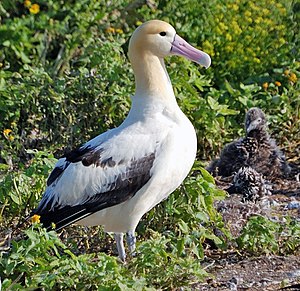Short-tailed albatross
| Short-tailed albatross | |
|---|---|
 |
|
| Scientific classification | |
| Kingdom: | Animalia |
| Phylum: | Chordata |
| Class: | Aves |
| Order: | Procellariiformes |
| Family: | Diomedeidae |
| Genus: | Phoebastria |
| Species: | P. albatrus |
| Binomial name | |
|
Phoebastria albatrus (Pallas, 1769) |
|
| Synonyms | |
|
Diomedea albatrus |
|
Diomedea albatrus
The short-tailed albatross or Steller's albatross (Phoebastria albatrus) is a large rare seabird from the North Pacific. Although related to the other North Pacific albatrosses, it also exhibits behavioural and morphological links to the albatrosses of the Southern Ocean. It was described by the German naturalist Peter Simon Pallas from skins collected by the Georg Wilhelm Steller (after whom its other common name is derived). Once common, it was brought to the edge of extinction by the trade in feathers, but with protection has recently made a recovery.
Short-tailed albatrosses are a type of albatross that belong to the family Diomedeidae, order Procellariiformes, along with shearwaters, fulmars, storm petrels, and diving petrels. They share certain identifying features. First, they have nasal passages that attach to the upper bill called naricorns. Although the nostrils on the albatross are on the sides of the bill. The bills of Procellariiformes are also unique in that they are split into between seven and nine horny plates. Finally, they produce a stomach oil made up of wax esters and triglycerides that is stored in the proventriculus. This is used against predators as well as an energy rich food source for chicks and for the adults during their long flights. They also have a salt gland which is situated above the nasal passage helping desalinate their bodies, as an adaptation to the high amount of ocean water they imbibe. It excretes a high saline solution from their nose. Going back in time, fossils of albatrosses from the mid- in Bermuda and North Carolina are considered to be closest to the short-tailed albatross.
...
Wikipedia

